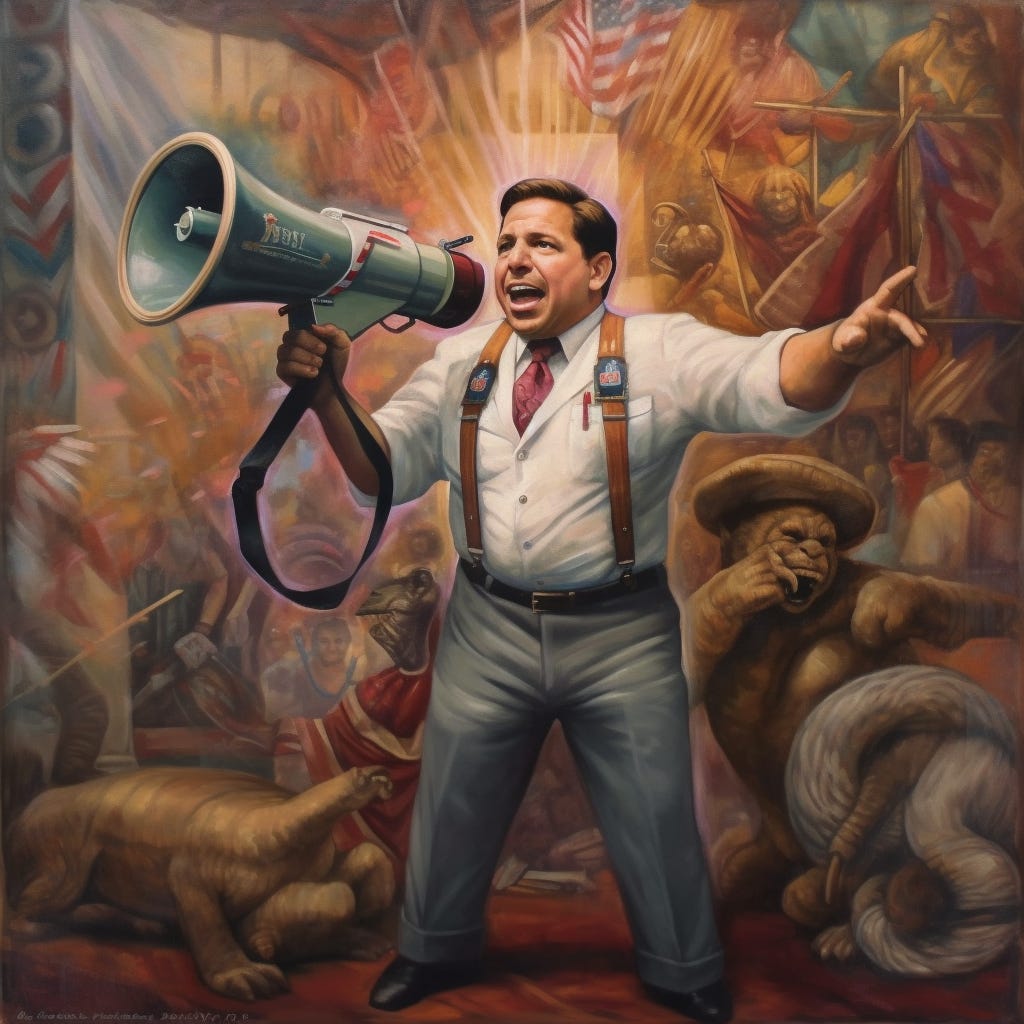

Discover more from Politics Politics Politics
There is no such thing as "Too Online"
Ron DeSantis' 2024 campaign launch bets that there is no mainstream
Picture a grand carousel. The centerpiece of an otherwise desolate fairground, its horses parade in unison, its lights dance in harmony, and its tunes hum the familiar melody of consensus.
The carousel matters, it’s grand and predictable. Those who understand it, benefit.
Outside the gates of the carousel, in the fairgrounds, stand the people. Waiting to get a glimpse. At some point, someone gets the idea to sell popcorn. Which becomes a trend. Eventually there are lines for concessions. And while people are waiting, little mini-carousels are set up. Crude at first, then increasingly complex. They’re easier to access than the big one and thus become more and more popular. Vibrant, chaotic, eclectic, a smorgasbord of attractions, each vying for attention, each distinctive, and each refusing to move in synchrony.
As the fairgrounds get more popular, the carousel falls into disrepair. The music stretched, the lights dimmed, the horses frozen mid-gallop.
What we once referred to as mainstream media consensus stands as still as the carousel. A slow decline reaching critical mass. The fairgrounds are the chaotic world of relatively decentralized internet communication.
Our national discourse has left the carousel and ventured out into this bustling carnival. We no longer find it echoing in the mainstream media of yesteryears — the stalwart newspapers, the trusted television networks, or the comprehensive cable channels. Instead, it thrives amidst the riotous landscape of the digital world. Here, in the discordant symphony of a million disparate voices, each American finds a niche echo of their beliefs and ideologies, a corner of the carnival that resonates with their unique perspectives.
Consider Florida Governor Ron DeSantis' recent launch on Twitter Spaces. The most popular news peg seems to focus on the technical errors in the first 20 minutes. Because presidential announcements are notoriously on-time affairs. Those that chose to listen to the hour and half after that found it too niche, too micro-targeted. Not mainstream enough.
I believe this presumes we still have a mainstream — the carousel we once all rode together.
Long before Ice Spice, there was a time when the nation's gaze was held by the front pages of newspapers, the glossy covers of influential magazines, and the homogenized messages of television coverage. All of them essentially a blending of the opinions of two dozen producers, editors and publishers. All of them in New York City.
Chronicling the death of newspapers and the evening broadcast news is practically old enough to legally drink at this point. Even the mainstream outlets which promised to be their heir apparents have begun decomposing. In 2020, there were about 71 million subscribers to cable TV platforms, this is expected to fall to 56 million by 2025. In 2021, just 56% of Americans watched cable or satellite TV, and 27% of U.S. households intended to cancel their cable and satellite subscriptions by the end of the year.
ESPN, the creator of cable carriage fees, is reportedly looking to sell direct to consumer by 2025. This will like hasten the death of the traditional cable “bundle.”
Another possible successor, powerful blog empires, are collapsing under their own weight even faster. Buzzfeed News is no longer. Vice is in the middle of bankruptcy. Gawker long since counted the lights under the weight of a powerful Hulk Hogan leg drop.
It’s not to say that broadcast and cable television, blogs, radio and newspaper empires hold no power. They’re just no longer the de facto starting or finishing point of the national conversation. We've dispersed, lured away by the cacophonous allure of the carnival beyond.
The mainstream, as we knew it, has fragmented into an incalculable number of micro-audiences. These digital tribes, each defined by specific interests, biases, and idioms, represent the new frontier of political engagement. In this brave new world, the game isn't about crafting a singular message to sway the masses. It's about curating a vibrant quilt of micro-messages, each expertly tailored to resonate with a specific tribe.
Does a particular campaign tactic seem excessively strident or arcane? Perfect. That twinge of alienation you feel is by design. It indicates that the message isn't meant for you, but for another tribe — a tribe whose language, passions, and quirks are reflected in that seemingly discordant message.
The 2023 version of “Yes We Can” will be dissolved to its atomic elements. Strange though it might be, the singular bits of a consensus could look a lot like “woke mind virus” and “dogecoin” two maligned topics of conversation during the hour and half DeSantis Twitter Spaces.
This isn't some dystopian vision of the future — this is the now. The gatekeepers of the old world have been dethroned. They no longer shape tastes and trends but merely try to keep pace with the zeitgeist of a million digital tribes. It’s why clearing houses of information like Twitter are still important. Otherwise, how will those in charge of keeping track of culture know what the hell is going on?
Was Governor DeSantis' strategy — a seemingly scattershot barrage of hyper-online partisan buzzwords — a wise move? The jury is still out. But to suggest that his campaign should have adopted a more homogenized, mainstream-friendly message is to look to the past to solve the challenges of the future.
As we embark on this presidential election — the first in an era where the media system that dominated the last 50 years has been rendered obsolete by a far more chaotic information landscape — we must accept that the old rules no longer apply.
The carousel is silent, the carnival thrives.
Subscribe to Politics Politics Politics
Unbiased political analysis the way you wish it existed? National political reporter and Billboard chart topping comedian explains the campaign trail. That’s the Politics Politics Politics podcast.







The author has discovered social media!